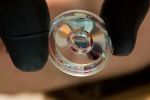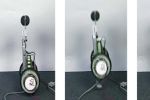Test Drive: The Electric Mini
Regenerative braking, the process through which an electric car grabs otherwise wasted energy from the brakes as the car glides to a halt, is a brilliant bit of engineering for efficiency—take energy that's otherwise only good for burning up brake pads, and turn it into electricity that charges the battery.
It may also make the uninitiated driver want to vomit. This is what my handler told me as she guided me toward a fleet of Mini Es—electric Mini Coopers—parked in the basement of the L.A. Convention Center in downtown Los Angeles. See, regenerative braking starts to slow the car as soon as you let off the gas, as the braking system harvests the energy emitted by the decelerating vehicle. The experience can be unsettling at first—it can trick you into thinking you've been driving with the parking brake on. You might end up lunging unexpectedly forward in your seat as the regen takes over, until you learn to let this magical automatic braking system do its thing. It takes a little practice to learn to smooth the transition between speeding up and slowing down, between starting and stopping. Until then, Mini's publicist told me, you might feel as if you need to pull over and grab some ginger ale.
But in my drive around LA in the Mini E, it took only a couple miles in the car to learn when to cede stopping power to the regenerative braking. By then I'd also gotten used to the other notable difference between this car and its gas-driven brethren—the eerie silence of a pure electric vehicle (the only sound is that of the tires rolling along the pavement). The Mini E is no glorified golf cart. It's a little slow off the line, but once you get moving acceleration is impressive. On one traffic-free straightaway I hit the accelerator and realized I'd been underestimating this car: My head snapped back as the car launched ahead. The route Mini planned for me didn't include any freeway driving, probably because I'd just end up sitting in traffic, but the car has a top speed of 95 mph. In other words, the Mini E drives pretty much like a normal Mini Cooper.
It looks pretty much identical to the standard Mini Cooper, too, but there are interesting differences. What used to be the backseat is now filled with lithium-ion batteries supplied by AC Propulsion. (That company supplied the entire powertrain—batteries, motor, power electronics and all.) Behind the steering wheel you'll find a battery-charge gauge. The cars are numbered. They come with a custom charger that churns out 240 watts at 50 amps, which means you can charge the car fully in two to three hours.
Popular Tags
Cars
Regular Features

| regarding | user | just commented |
|---|---|---|
| Happy 30th Birthday, Compact Disc! | Ulyssus | Its older than me!!! What |
| Drinking Adds to Cancer Risk | Ulyssus | Be careful what you wish for |
| Greening the World of Warcraft? | We_Major | I kind of hope they review |
| Play It Again, Sam | We_Major | I remember playing the first |
| Drinking Adds to Cancer Risk | We_Major | I saw a story on the Channel |
Featured
Cars
How It Works: Tomorrow's Hybrid
A plug-in concept from Volvo brings the power inside the wheels for increased efficiency and extra mileageBlasts From the Past at the New York Auto Show
At this year's NYIAS, nostalgia is king. Launch our gallery to see why
Popular on Popsci
Most Viewed
Cars
- The Push for Solar Energy in New York Gets a Boost at a Bar
- Speeding Past the Competition
- The Push for Solar Energy in New York Gets a Boost At a Bar
- Test Drive: 2009 Porsche Boxster S
- Tested: Nissan GT-R
- PopSci to test drive the Nissan GT-R
- Solar Powered Shaggin’ Wagon
- Charging Ahead - The Tesla Electric Car Story
Most Commented
Cars
- PopSci to test drive the Nissan GT-R
- Tested: Nissan GT-R
- Charging Ahead - The Tesla Electric Car Story
- Test Drive: 2009 Porsche Boxster S
- Solar Powered Shaggin’ Wagon
- Speeding Past the Competition
- The Push for Solar Energy in New York Gets a Boost at a Bar
- The Push for Solar Energy in New York Gets a Boost At a Bar
Most Emailed
Cars
- The Push for Solar Energy in New York Gets a Boost at a Bar
- Charging Ahead - The Tesla Electric Car Story
- Test Drive: 2009 Porsche Boxster S
- Solar Powered Shaggin’ Wagon
- Speeding Past the Competition
- The Push for Solar Energy in New York Gets a Boost At a Bar
- Tested: Nissan GT-R
- PopSci to test drive the Nissan GT-R








